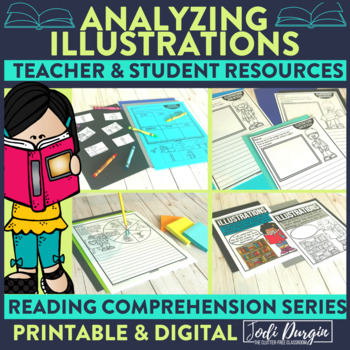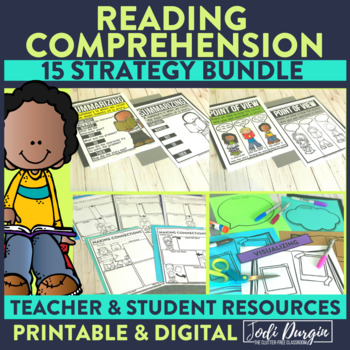Analyzing illustrations in children’s books is an important reading comprehension strategy for elementary students to become proficient in. When readers analyze illustrations, they are using the pictures to help them collect more information about the setting, plot, characters and more. It helps readers better understand and enjoy stories they read and listen to. Learn how to teach about analyzing illustrations in children’s books below!
What is Using Illustrations to Understand Text?
Oftentimes, using the illustrations from a picture book is an overlooked reading skill. However, this strategy can be extremely beneficial to students. When readers analyze illustrations, they are using the pictures to help them better understand the story. Sometimes, the illustrations provide meaning that the words might not say or they provide clues about what characters are thinking, feeling, or might do next.
Students can also analyze illustrations by discussing what the illustrator did throughout the book to help with the reader’s understanding and make the book more enjoyable. For beginning readers, analyzing the illustrations is an important strategy for decoding the text and comprehending what the author is saying. Looking at the pictures will help these readers have a better idea of what words they might be reading.
Why Is Using Illustrations to Understand Text an Important Comprehension Strategy?
Analyzing illustrations in children’s books is important for a number of reasons. Readers often use the illustrations to help them better understand the character and setting of a story. The words might not give details about what a character looks like or where a book takes place. Taking the time to look over the illustrations can provide readers with these answers.
Illustrations also help readers to make inferences and predictions. Commonly, there are clues in the illustrations that show readers what might happen next or what characters are thinking or feeling. The illustrations paired with text help to support students’ thinking throughout the book.
Finally, analyzing illustrations becomes even more important when readers are struggling to make sense of what they read and comprehend a text. Students can look at what is happening in the pictures to clarify questions they might have, modify their thinking, or better understand what they read.
Teaching Standards for Analyzing Illustrations
Standards for this reading comprehension topic include…
CCSS
- RL.1.7: Use illustrations and details in a story to describe its characters, setting, or events.
- RL.2.7: Use information gained from the illustrations and words in a print or digital text to demonstrate understanding of its characters, setting, or plot.
- RL.3.7: Explain how specific aspects of a text’s illustrations contribute to what is conveyed by the words in a story (e.g., create mood, emphasize aspects of a character or setting).
- RL.4.7: Make connections between the text of a story or drama and a visual or oral presentation of the text, identifying where each version reflects specific descriptions and directions in the text.
- RL.5.7: Analyze how visual and multimedia elements contribute to the meaning, tone, or beauty of a text (e.g., graphic novel, multimedia presentation of fiction, folktale, myth, poem).
TEKS
- LA.1.3.B: Developing and sustaining foundational language skills: listening, speaking, reading, writing, and thinking–vocabulary. The student uses newly acquired vocabulary expressively. The student is expected to: use illustrations and texts the student is able to read or hear to learn or clarify word meanings;
- LA.2.3.B: Developing and sustaining foundational language skills: listening, speaking, reading, writing, and thinking–vocabulary. The student uses newly acquired vocabulary expressively. The student is expected to: use context within and beyond a sentence to determine the meaning of unfamiliar words;
- LA.3.3.B: Developing and sustaining foundational language skills: listening, speaking, reading, writing, and thinking–vocabulary. The student uses newly acquired vocabulary expressively. The student is expected to: use context within and beyond a sentence to determine the meaning of unfamiliar words and multiple-meaning words;
- LA.4.3.B: Developing and sustaining foundational language skills: listening, speaking, reading, writing, and thinking–vocabulary. The student uses newly acquired vocabulary expressively. The student is expected to: use context within and beyond a sentence to determine the relevant meaning of unfamiliar words or multiple-meaning words;
- LA.5.3.B: Developing and sustaining foundational language skills: listening, speaking, reading, writing, and thinking–vocabulary. The student uses newly acquired vocabulary expressively. The student is expected to: use context within and beyond a sentence to determine the relevant meaning of unfamiliar words or multiple-meaning words;
3 Tips for Teaching Students to Analyze Illustrations
Below are suggestions for when you’re teaching your students to analyze illustrations when reading.
1. Read Aloud Picture Books
Reading aloud picture books is a great way to model and practice this reading comprehension strategy. There are tons of great read alouds out there for teaching students to analyze the illustrations of a book. Some high-quality examples include Who Wet My Pants, Same, Same but Different, Owl Babies, A Sick Day for Amos McGee, and Dragons Love Tacos.
2. Make Anchor Charts
Anchor charts are another great way to teach students about analyzing illustrations in children’s books. My analyzing illustrations resource includes an interactive anchor chart. It successfully engages students in their learning and provides a visual learning experience for students to learn about analyzing illustrations.
3. Use Videos
The third on the list of tips for teaching students to analyze illustrations is playing videos. This is another great visual learning opportunity for students to learn about what can feel like a very abstract idea. This is an example of a video that is great for teaching students how to analyze illustrations in picture books.
Resources for Teaching How to Analyze Illustrations
These printable and digital resources for teaching elementary students about analyzing illustrations in children’s books are very helpful. They make curriculum and lesson planning quick and easy. It includes teacher, parent, and student resources. You’ll have everything you need to deliver meaningful research-based instruction rooted in current best practices.
What is Included
1. Teacher Resources
There are teacher notes about the strategy, teaching ideas, a planning page with question prompts, and list of mentor texts, so you have all of the information you need to plan a research and standards-based reading unit based on this reading comprehension strategy.
2. Parent Resources
There is a parent letter and a reading log with suggested question prompts so parents can confidently support and reinforce the strategy you are teaching with their children at home.
3. Instructional Resources
There are printables to create a large anchor chart and reference charts. Both save you lots of time searching for anchor chart ideas and supplemental teaching tools.
4. Student Resources
There are 3 printables and 2 activities for students that provide meaningful opportunities to practice and make sense of the reading strategy in a fun and engaging way.
5. Digital Resources
There are digital versions of several of the resources so students can access them in school or at home using a technology device of their choice.
Why Teachers Love this Resource
- This collection of resources is versatile. Use it on it’s own or use it to supplement any reading curriculum. You will be able to continue to use these resources if your school adopts a new reading program or you switch school districts.
- This resource is part of a larger collection of reading strategy products, so you can provide a consistent instructional approach that your students quickly learn and understand the expectations and routines for. Learn more about this collection here!
- It’s a huge time saver! You won’t need to hunt for background information on a reading strategy or search for resources to teach the strategy. This comprehensive resource includes all of the information and resources you need to teach a whole unit on this reading strategy.
- The student activities are a lot of fun for students. This helps create a productive learning environment where students are engaged and learning!
- It includes resources that provide a great way to create a home-school connection with students’ families and support parents/guardians in continuing student learning at home.
In closing, we hope you found this post about how to teach analyzing illustrations in children’s books helpful! If you did, then you may also be interested in this other post about elementary reading comprehension strategies.




